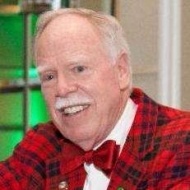John LaFoy, a past president of the American Society of Golf Course Architects, heads his own design firm based in  Greenville, South Carolina. He began his design career with George W. Cobb. His opportunity to help Cobb with the remodeling of Augusta National Golf Club led to LaFoy remodeling many classic layouts, including those of architects A.W. Tillinghast, Alister Mackenzie, Seth Raynor, Charles Blair MacDonald, and numerous Donald Ross designs. John has also designed and renovated more than a hundred courses, including the Country Club of Charleston in Charleston, South Carolina; Country Club of Birmingham in Birmingham, Alabama; Linville Ridge Country Club and Neuse Golf Club in North Carolina; and Glenmore Country Club in Charlottesville, Virginia.
Greenville, South Carolina. He began his design career with George W. Cobb. His opportunity to help Cobb with the remodeling of Augusta National Golf Club led to LaFoy remodeling many classic layouts, including those of architects A.W. Tillinghast, Alister Mackenzie, Seth Raynor, Charles Blair MacDonald, and numerous Donald Ross designs. John has also designed and renovated more than a hundred courses, including the Country Club of Charleston in Charleston, South Carolina; Country Club of Birmingham in Birmingham, Alabama; Linville Ridge Country Club and Neuse Golf Club in North Carolina; and Glenmore Country Club in Charlottesville, Virginia.
My first visit to the Augusta National Golf Club was in 1962 when I was a sophomore in high school. I knew a little about the golf course, since my best friend’s dad, George Cobb, had designed the Par-three course there, but like most teenagers, I never dreamed that I would one day be a golf course architect and actually work there.
Fast-forward about seven years–four years in college, three years in the Marines as a combat engineer officer–and a brand new job as an apprentice architect to George Cobb.
Mr. Cobb was a wonderfully talented architect who never really received the credit he is due. He also happened to be the consulting architect at the Augusta National. I was fortunate to have made all the trips to Augusta with him from 1973 through 1978, the year after Augusta National’s legendary chairman Clifford Roberts died.
During our time there, it would have been nice to claim that we were the consulting architects for the Augusta National, but Mr. Cobb had a letter in his files from the green chairman saying that nothing from our office could promote or tout our work at the Augusta National Golf Club.
I’ll never forget my first visit there to actually work. Mr. Cobb and I walked into a meeting a couple of minutes after it had commenced and Roberts was holding court. There were a number of Augusta National members who were industry giants, including David Lilly, Chairman of the Toro Company, in the room.
Roberts turned from them to face me and asked, “Are you George’s bunker man?”
Before I could open my mouth, Mr. Cobb spoke up. “Mr. Roberts,” he said, “I will be responsible for anything coming out of my office.”
I soon understood that we were not there for casual conversation. I’m not sure that I opened my mouth the entire day, which I eventually figured out was probably smart!
After the brief, to-the-point meeting, we all piled into a van and started toward the first fairway. Mr. Roberts made a point to instruct that if any member of the group had anything to say, they should say it to the entire group. There would be no talking between ourselves.
About halfway up the first fairway, a couple of the high-ranking industry leaders started to chat.
“Stop the car!” Roberts commanded to the driver.
Then he turned around to the passengers and proceeded to scold them in a manner in which I wouldn’t talk to a dog! They should have known better than to defy him since they knew Clifford Roberts very well. As a Marine platoon commander whose primary job was to clear land mines and booby traps from the highway just south of Da Nang only a few years earlier, I was not going to be intimidated by much. But I saw these grown men and captains of industry, with much more clout than me, wilt under a pretty good tongue lashing from Roberts!
I actually got along quite well with Mr. Roberts, and soon learned that he was one of those leaders who just wanted the truth. People got in trouble with him when they told him what they thought he wanted to hear instead of the truth. Roberts later referred to me as his “bunker man,” and I was fortunate to have renovated many of the bunkers and many of the tees on the golf course, as well as several greens, including the famous thirteenth green.
